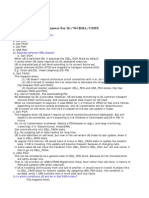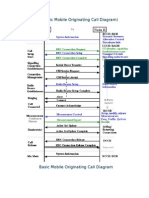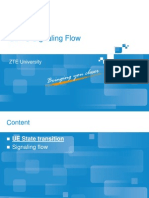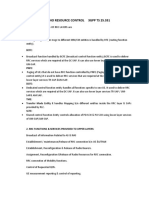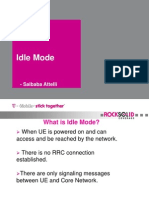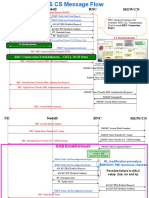Idle Connected 1-Idle Mode
Idle Connected 1-Idle Mode
Uploaded by
Bhavik ChavdaCopyright:
Available Formats
Idle Connected 1-Idle Mode
Idle Connected 1-Idle Mode
Uploaded by
Bhavik ChavdaOriginal Description:
Original Title
Copyright
Available Formats
Share this document
Did you find this document useful?
Is this content inappropriate?
Copyright:
Available Formats
Idle Connected 1-Idle Mode
Idle Connected 1-Idle Mode
Uploaded by
Bhavik ChavdaCopyright:
Available Formats
THERE ARE TWO TYPES OF RRC STATES IN WCDMA
IDLE
CONNECTED
1- IDLE MODE :
A-UE SWITCHED ON
B- IT CONDUCTS THE CELL SEARCH PROCEDURE & TUNES TO THE CONTROL CHANNEL OF
AN APPROPRIATE CELL
C- AFTER CAMPING ON A CELL UE CAN RECEIVE SYATEM INFO & BROADCAST MSG.
2- CONNECTED MODE: THERE ARE 4 TYPES IN THIS MODE
2.1 CELL DCH
2.2 CELL PCH
2.3 CELL FACH
2.4 URA PCH.
CELL_DCH state is characterized by:
A dedicated physical channel is allocated to the UE in uplink and downlink.
The UE is known on cell level according to its current active set.
Dedicated transport channels, downlink and uplink (TDD) shared transport
channels, and a combination of these transport channels can be used by the
UE.
CELL_FACH state is characterized by:
No dedicated physical channel is allocated to the UE.
The UE continuously monitors a FACH in the downlink.
The UE is assigned a default common or shared transport channel in the uplink
(e.g. RACH) that it can use anytime according to the access procedure for
that transport channel.
The position of the UE is known by UTRAN on cell level according to the cell
where the UE last made a cell update.
In TDD mode, one or several USCH or DSCH transport channels may have been
established.
CELL_PCH state is characterized by:
No dedicated physical channel is allocated to the UE.
The UE selects a PCH with the algorithm, and uses DRX for monitoring the
selected PCH via an associated PICH.
No uplink activity is possible.
The position of the UE is known by UTRAN on cell level according to the cell
where the UE last made a cell update in CELL_FACH state.
URA_PCH State is characterized by:
No dedicated channel is allocated to the UE.
The UE selects a PCH with the algorithm, and uses DRX for monitoring the
selected PCH via an associated PICH.
No uplink activity is possible.
The location of the UE is known on UTRAN Registration area level according to
the URA assigned to the UE during the last URA update in CELL_FACH state.
Now lets take a general example of all above mentioned stages.
Suppose I connect a Data card & when the connection established a homepage is opened. Now
if we dont do any kind of further activity then the UE will be Cell_FACH mode. It is used for
smaller data transfer like 32Kb.
If we started large data transfer then the UE will be in Cell_DCH mode means a dedicated
channel will be assigned to the user.
After Cell_FACH mode suppose we didnt do anything & the inactivity timer is expired then the
stage of UE would be either in Cell_PCH mode or in URA_PCH.
Cell_PCH mode is kept for those users who are in a single cell. They are not roaming anywhere .
Throughout the time they will be in a single cell (in case of Data Card)
Now for those users whose cell update happens frequently at that time the UEs will be in
URA_PCH mode (URA= UMTS Radio Area).
In URA_PCH Mode we will be having a group of Cells together define as a URA ID so that UE will
only update their location when their URA ID will change.
During the paging time if the UE is in Cell_PCH mode at that time paging occurs only for that
particular Cell form which UE is Presently latched on. Where as in URA_PCH mode paging occurs
for Particular URA_ID in which its also pages the Cells that are present in that particular URA_ID.
Due to this Keeping the User in URA_PCH mode Paging Load will increase in the Network.
So in Release 7 a new feature is introduced that is called CPC (Continuous Packet Connectivity ).
Enabling CPC on those particular cells where user paging behavior is like that , so what UE will
do when the inactivity timer is going to be expire, UE will send a bit so that timer will never
expire for only that kind of users & the paging load will also decrease in the network & the UE
will always remain in Cell_FACH mode.
*Cell_PCH mode is not there in Ericsson System
Some Ericsson Radio Connection Supervision (RCS) Parameters are listed below
1. cchWaitCuT: Waiting timer for cell update.
2. t305: The maximum time between adjacent Cell Updates (UE in CELL_FACH
state) or URA Update (UE in URA_PCH state). Infinity means no update.
3. rlFailureT: Guard period before sending RL Failure.
4. nInSyncInd: Number of frames to be considered for in-sync detection.
5. nOutSyncInd: Number of frames to be considered for out-of-sync detection.
dchRcLostTTimer that is started when all radio links for a connection are lost. At time-out, the
radio connection is considered lost.
6. blerQualityTargetDl: BLER quality target in the downlink.
This attribute is valid only if CRC is used.
7. blerQualityTargetUl: BLER quality target in the uplink.
This attribute is valid only if CRC is used.
8. hsDschRcLostT: Controls the RCS timer for supervision of uplink synch of RLS
containing the serving HS-DSCH radio link.
You might also like
- What Is Pilot PollutionDocument30 pagesWhat Is Pilot PollutionSharmistha Talukder Khastagir100% (4)
- Design Standards For Muslim Prayer Facilities Within Public BuildingsDocument7 pagesDesign Standards For Muslim Prayer Facilities Within Public BuildingsRaenier Gonzales Ramos100% (1)
- UMTS Interview Questions and AnswerDocument24 pagesUMTS Interview Questions and AnswervikydilseNo ratings yet
- RRC ModesDocument2 pagesRRC ModesSandip SarkarNo ratings yet
- 3g RRC StateDocument5 pages3g RRC StateADEYINKA ELIZABETHNo ratings yet
- Cell PCH Ura PCHDocument2 pagesCell PCH Ura PCHSYANo ratings yet
- 3G / Wcdma / Umts: Thursday, 12 January 2012Document9 pages3G / Wcdma / Umts: Thursday, 12 January 2012manish_chaturvedi_19No ratings yet
- UMTS IntrviewDocument40 pagesUMTS IntrviewShahnawaz AnjumNo ratings yet
- Question & Answer For 3G / WCDMA / UMTSDocument9 pagesQuestion & Answer For 3G / WCDMA / UMTSBromand TurkmaniNo ratings yet
- Umts RRC States and SRBDocument4 pagesUmts RRC States and SRBKrishna Prasad PheluNo ratings yet
- 3g - Wcdma - Umts - Interview Question & Answer For 3g - Wcdma - UmtsDocument6 pages3g - Wcdma - Umts - Interview Question & Answer For 3g - Wcdma - UmtsAnthony TiribaNo ratings yet
- RRC States UMTSDocument3 pagesRRC States UMTSJuwalNo ratings yet
- Interview Questions of UmtDocument9 pagesInterview Questions of UmtdibyajitsamNo ratings yet
- Ura UraDocument4 pagesUra Uradebraj230No ratings yet
- Interview Question & Answer For 3G / WCDMA / UMTSDocument9 pagesInterview Question & Answer For 3G / WCDMA / UMTSoptimistixNo ratings yet
- Interview Question & Answer For 3G / WCDMA / UMTSDocument4 pagesInterview Question & Answer For 3G / WCDMA / UMTSgupta00712No ratings yet
- Downlink Out of Sync EricssonDocument5 pagesDownlink Out of Sync EricssonDanielNo ratings yet
- 1) What Are The RRC States?: 2) A. Cell DCHDocument14 pages1) What Are The RRC States?: 2) A. Cell DCHharikrishnachNo ratings yet
- UMTS Interview Questions:: 1) What Are The RRC States?Document5 pagesUMTS Interview Questions:: 1) What Are The RRC States?anurag_singh39No ratings yet
- UMTS Interview Questions: 1) What Are The RRC States?: A. Cell DCHDocument16 pagesUMTS Interview Questions: 1) What Are The RRC States?: A. Cell DCHSurajit JatiNo ratings yet
- Nemo Analysis WorkshopDocument192 pagesNemo Analysis Workshopessenvee1No ratings yet
- 04 WO - BT05 - E1 - 1 UMTS Signaling Flow-62Document62 pages04 WO - BT05 - E1 - 1 UMTS Signaling Flow-62عبدالرحمن دقداقNo ratings yet
- A Dedicated Physical Channel Is Allocated To The UE in Uplink and Downlink. The UE Is Known On Cell Level According To Its Current Active SetDocument2 pagesA Dedicated Physical Channel Is Allocated To The UE in Uplink and Downlink. The UE Is Known On Cell Level According To Its Current Active SetVusal SuleymanovNo ratings yet
- Call Setup: (Basic Mobile Originating Call Diagram)Document4 pagesCall Setup: (Basic Mobile Originating Call Diagram)Kr RavindraNo ratings yet
- Radio Link Failure Event WCDMADocument13 pagesRadio Link Failure Event WCDMArecg2011No ratings yet
- CELL - DCH State Is Characterised byDocument1 pageCELL - DCH State Is Characterised byambika_sNo ratings yet
- Cell PCHDocument13 pagesCell PCHBineesh23No ratings yet
- WCMDA 04 Radio Connection SupervisionDocument19 pagesWCMDA 04 Radio Connection SupervisionHien Nguyen100% (1)
- UMTS Interview Questions:: 2) A. Cell DCHDocument3 pagesUMTS Interview Questions:: 2) A. Cell DCHAnjit RajkarnikarNo ratings yet
- Nemo Analysis WorkshopDocument210 pagesNemo Analysis WorkshopZain Ul Abedin Butt100% (1)
- 4 UMTS Signaling Flow-62Document57 pages4 UMTS Signaling Flow-62Camilo Bazan HerediaNo ratings yet
- 5.WO BT05 E1 1 UMTS Signaling Flow-62Document62 pages5.WO BT05 E1 1 UMTS Signaling Flow-62Tri NguyenNo ratings yet
- LTE Questions and Answers - 3Document4 pagesLTE Questions and Answers - 3Rishant ThakurNo ratings yet
- 5.WO BT05 E1 1 UMTS Signaling Flow-62Document62 pages5.WO BT05 E1 1 UMTS Signaling Flow-62Huong NguyenNo ratings yet
- Nemo Analysis by Log FileDocument192 pagesNemo Analysis by Log FileSyamsulNo ratings yet
- UMTS Signaling Flow: ZTE UniversityDocument62 pagesUMTS Signaling Flow: ZTE UniversityJonathan Ruiz DakerNo ratings yet
- Umts Radio Resource Control 3gpp Ts 25Document4 pagesUmts Radio Resource Control 3gpp Ts 25ismoilNo ratings yet
- High Speed DL FachDocument23 pagesHigh Speed DL FachSumon Kumar BiswasNo ratings yet
- Downlink/uplink Data TransferDocument24 pagesDownlink/uplink Data TransfervaishnaviNo ratings yet
- (ZTE) UMTS-signaling-flowDocument54 pages(ZTE) UMTS-signaling-flowdvc.290603No ratings yet
- Chapter 6 Basic Signaling ProceduresDocument68 pagesChapter 6 Basic Signaling ProceduresEfosa AigbeNo ratings yet
- 2) Describe Different RRC States? A. Cell DCHDocument2 pages2) Describe Different RRC States? A. Cell DCHVusal SuleymanovNo ratings yet
- Fast Dormancy: Release 8Document4 pagesFast Dormancy: Release 8BinSimoNo ratings yet
- 07-WCDMA UTRAN Signaling ProcedureDocument89 pages07-WCDMA UTRAN Signaling ProcedureMalik Pervaiz IqbalNo ratings yet
- 5.WO - BT05 - E1 - 1 UMTS Signaling Flow-62Document62 pages5.WO - BT05 - E1 - 1 UMTS Signaling Flow-62KassyeNo ratings yet
- 04 TM51104EN03GLA3 ProceduresDocument136 pages04 TM51104EN03GLA3 ProceduresEdward OkothNo ratings yet
- 3g Serving Cell Events Active Set Monitored SetDocument9 pages3g Serving Cell Events Active Set Monitored Settrxopti9100% (9)
- Idle Mode: - Saibaba AttelliDocument30 pagesIdle Mode: - Saibaba AttelliserafettinbNo ratings yet
- 3GPP Interview QuestionsDocument8 pages3GPP Interview QuestionsManas Ranjan Sahu100% (1)
- WCDMA Idle Mode Behaviour HuaweiDocument32 pagesWCDMA Idle Mode Behaviour Huaweihuseyin100% (2)
- Day 2 - Wran OperationsDocument32 pagesDay 2 - Wran OperationsAnup SinghNo ratings yet
- LTE MeasurementsDocument36 pagesLTE MeasurementsAnonymous VHXJw23L2l100% (1)
- 36300-8c0 DRX抜粋Document2 pages36300-8c0 DRX抜粋Ketu MaruNo ratings yet
- STDocument15 pagesSTSoumaya DahechNo ratings yet
- State 3GDocument28 pagesState 3GSoumaya DahechNo ratings yet
- Radio Control for Model Ships, Boats and AircraftFrom EverandRadio Control for Model Ships, Boats and AircraftRating: 5 out of 5 stars5/5 (1)
- Investigation of the Usefulness of the PowerWorld Simulator Program: Developed by "Glover, Overbye & Sarma" in the Solution of Power System ProblemsFrom EverandInvestigation of the Usefulness of the PowerWorld Simulator Program: Developed by "Glover, Overbye & Sarma" in the Solution of Power System ProblemsNo ratings yet
- Methods for Increasing the Quality and Reliability of Power System Using FACTS DevicesFrom EverandMethods for Increasing the Quality and Reliability of Power System Using FACTS DevicesNo ratings yet
- Cid (All) Hs User Throughput KbpsDocument29 pagesCid (All) Hs User Throughput KbpsBhavik ChavdaNo ratings yet
- 3G Baseline ParametersDocument337 pages3G Baseline ParametersBhavik ChavdaNo ratings yet
- Cluster Level TrendingDocument83 pagesCluster Level TrendingBhavik ChavdaNo ratings yet
- DRSNK13 - High DCR - U21-RYG0093-2A & U21-RYG0028-2ADocument14 pagesDRSNK13 - High DCR - U21-RYG0093-2A & U21-RYG0028-2ABhavik ChavdaNo ratings yet
- Eul Serving Cell Users AdmDocument11 pagesEul Serving Cell Users AdmBhavik ChavdaNo ratings yet
- Bspsi10 Kpi Report 3'13Document2 pagesBspsi10 Kpi Report 3'13Bhavik ChavdaNo ratings yet
- Ue RNC Nodeb MGW/CN: RRC Connection Establishment - Cell DCH StateDocument13 pagesUe RNC Nodeb MGW/CN: RRC Connection Establishment - Cell DCH StateRohit JainNo ratings yet
- Lecture Slides Lecture6 HTML Css JsDocument7 pagesLecture Slides Lecture6 HTML Css JsPratik ShahNo ratings yet
- Tutorial On Configuring BIND To Use Response Policy Zones (RPZ)Document20 pagesTutorial On Configuring BIND To Use Response Policy Zones (RPZ)kjlopezpNo ratings yet
- SOA Suite 12.2.1.1.0 - Create Configure and Tune A SOA - OSB DomainDocument55 pagesSOA Suite 12.2.1.1.0 - Create Configure and Tune A SOA - OSB DomainRymanNo ratings yet
- Chris Juarez ResumeDocument1 pageChris Juarez Resumeapi-487648580No ratings yet
- Carriage ChartDocument10 pagesCarriage ChartSuperintending Engineer IPH Circle SundernagarNo ratings yet
- Krier-Peter Eisenman DialogueDocument3 pagesKrier-Peter Eisenman DialogueAndreea CarabusNo ratings yet
- ArchitectsDocument4 pagesArchitectsshreyashyadavNo ratings yet
- Implementation of Automatic Color Mixing and Filling Using PLC & SCADADocument6 pagesImplementation of Automatic Color Mixing and Filling Using PLC & SCADAJaya ShreeNo ratings yet
- Windows 10 Freezes Randomly (Solved) - Driver EasyDocument25 pagesWindows 10 Freezes Randomly (Solved) - Driver Easychandresh_johnsonNo ratings yet
- 2a. Specs For Valves - IADocument4 pages2a. Specs For Valves - IAPraveen KasrottaranNo ratings yet
- Object Oriented Programminng Using JAVADocument2 pagesObject Oriented Programminng Using JAVAANIPAM SURNo ratings yet
- Complete List of PeopleTools Tables v1Document18 pagesComplete List of PeopleTools Tables v1Lokesh Reddy KR100% (1)
- Odin Downloader Release NotesDocument60 pagesOdin Downloader Release NoteselianaNo ratings yet
- Vastu ShastraDocument7 pagesVastu Shastraarchitect AJNo ratings yet
- Cambridge International AS and A Level Computer Science: Topic Support GuideDocument13 pagesCambridge International AS and A Level Computer Science: Topic Support GuideTrynosNo ratings yet
- IoT Building A Raspberry Pi Security System With Facial Recognition - David - GsponerDocument55 pagesIoT Building A Raspberry Pi Security System With Facial Recognition - David - GsponerTheo PamoengkasNo ratings yet
- iOS Soap Webservice Calling and Parsing The ResponseDocument5 pagesiOS Soap Webservice Calling and Parsing The ResponseSaf BesNo ratings yet
- Using Nzs 3604 Timber Framed Buildings 239Document3 pagesUsing Nzs 3604 Timber Framed Buildings 239Ada bai0% (1)
- Plumbing - TR BaliDocument84 pagesPlumbing - TR BaliardibujangNo ratings yet
- Cold RollingDocument8 pagesCold Rollingpoom2007No ratings yet
- #دليل الحركه الشهريه عن طريق ال Web Service#Document22 pages#دليل الحركه الشهريه عن طريق ال Web Service#shifaNo ratings yet
- Woodsmith 215 Oct-Nov 2014Document54 pagesWoodsmith 215 Oct-Nov 2014ArnaldoeCrisPrimavera100% (1)
- Mix Design For Concrete Grade M 25Document7 pagesMix Design For Concrete Grade M 25fevahe756100% (1)
- Seminar Report PDFDocument40 pagesSeminar Report PDFAnusha RNo ratings yet
- Perforated Ceiling Tiles: Case Study TietgenkolliegietDocument5 pagesPerforated Ceiling Tiles: Case Study TietgenkolliegietPopoviciMikyNo ratings yet
- Night Sky Radiant Cooling - Misfits' ArchitectureDocument14 pagesNight Sky Radiant Cooling - Misfits' ArchitectureKasturirangan NarayananNo ratings yet
- Futuristic Architecture GherkinDocument13 pagesFuturistic Architecture GherkinshivangiNo ratings yet
- OSI Reference ModelDocument6 pagesOSI Reference ModelPratimaNo ratings yet
- Find Account Lockout Source For Logon Type 8Document2 pagesFind Account Lockout Source For Logon Type 8Amartya KaranNo ratings yet













